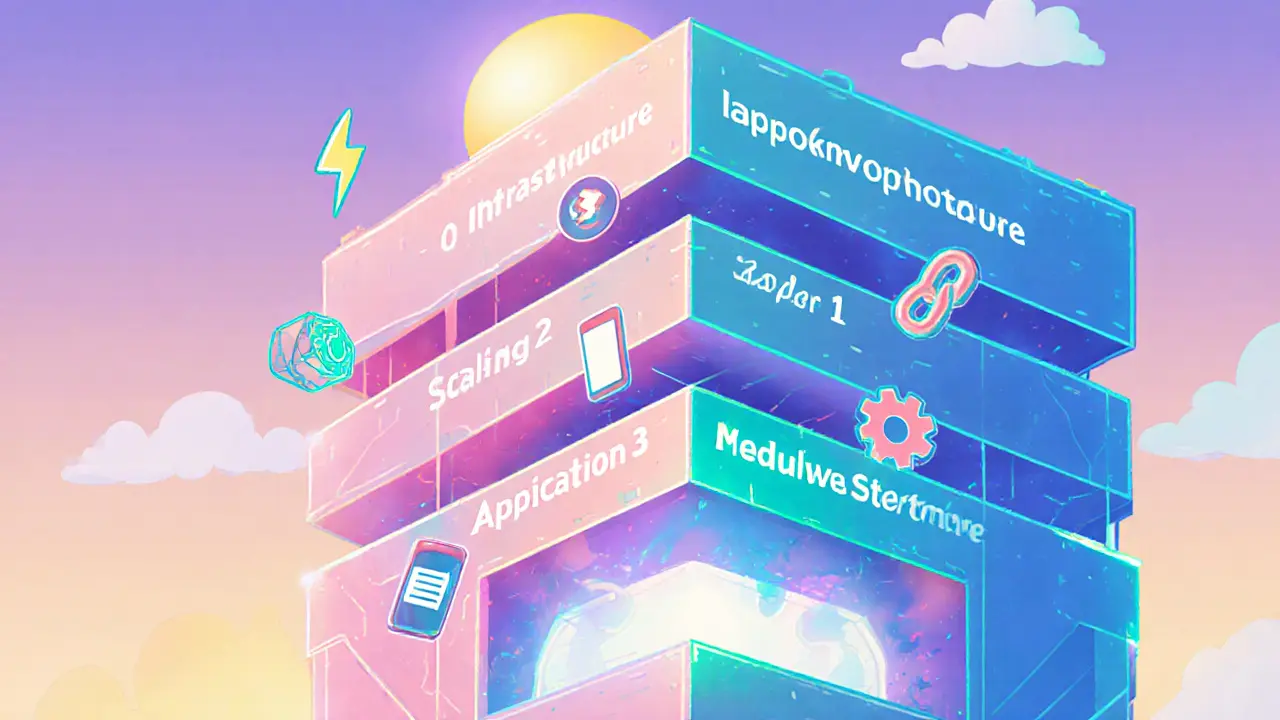
Web3 Stack Layer Explorer
Click on any layer below to learn more about its function and key technologies.
Layer 0
InfrastructureLayer 1
ProtocolsLayer 2
ScalingLayer 3
ServicesLayer 4
ApplicationsSelect a Layer to Learn More
Choose a layer from above to view detailed information about its role in the Web3 stack.
Pro Tip
Each layer builds upon the previous one, creating a robust foundation for decentralized applications. Understanding how they work together helps developers choose the right tools for their projects.
Quick Take
- Web3 runs on a multi‑layer stack from raw network infrastructure up to user‑facing dApps.
- Core layers include Layer 0 (infra), Layer 1 (protocol), Layer 2 (utilities), Layer 3 (services) and Layer 4 (applications).
- Key building blocks are blockchain, smart contracts (self‑executing code that lives on the blockchain), decentralized storage, and identity solutions.
- Developers use Solidity, the EVM, and tools like Hardhat or Truffle to write, test, and deploy code.
- Choosing the right layer‑2 scaling solution can cut gas fees by up to 90% while keeping security.
What the Web3 technology stack is a collection of protocols, tools, and services that enable decentralized applications (dApps) looks like
Imagine building a house. You start with a foundation, then walls, plumbing, electricity, and finally the interior design. Web3 follows the same pattern: each layer adds a specific capability, and together they let you create trustless, user‑controlled apps.
Layer0 - The Infrastructure Backbone
The lowest rung, often called Layer 0 (the network layer that provides peer‑to‑peer connectivity and hardware resources), is where node operators run full clients, maintain consensus, and keep the network alive. Projects like Cosmos, Polkadot, and Avalanche build cross‑chain bridges here, allowing separate blockchains to talk to each other.
Layer1 - Core Protocols and Consensus
On top of the infrastructure sits Layer 1 (the base blockchain that defines transaction ordering, state transition rules and native token economics). Ethereum, Solana, and Cardano are the most widely known examples. They differ in:
- Consensus mechanism: Proof of Work (PoW), Proof of Stake (PoS), Delegated PoS (DPoS) or Practical Byzantine Fault Tolerance (PBFT).
- Virtual machine: The Ethereum Virtual Machine (EVM) (a sandboxed runtime that executes smart contracts on Ethereum‑compatible chains) powers most dApps today.
Layer2 - Scaling Utilities
When demand spikes, Layer 1 can become expensive. Layer 2 (off‑chain or side‑chain solutions that batch transactions and settle them on the main chain) solves that. Rollups (Optimistic, ZK), State Channels, and Plasma are the big three. They keep security guarantees while shaving gas costs dramatically.
Layer3 - Services for dApp Development
Developers rarely interact with the blockchain directly. Instead they rely on services that abstract complexity. This is Layer 3 (the middleware layer offering APIs, analytics, and deployment tools). Notable players include:
- Node providers like QuickNode or Alchemy - they run the heavy lifting of syncing full nodes.
- Oracles such as Chainlink - they feed real‑world data into smart contracts.
- Identity hubs like Decentralized identity (self‑sovereign identifiers stored on‑chain, e.g., uPort, Civic).

Layer4 - The End‑User Experience
The topmost layer is where users actually interact with a dApp. It includes web front‑ends, mobile wallets, and browser extensions. Metamask (a browser extension that injects a Web3 provider, letting users sign transactions) is the de‑facto gateway, but alternatives like Trust Wallet or MyCrypto serve similar roles.
Smart Contracts & the Development Toolbox
At the heart of any Web3 app are smart contracts (programs that automatically enforce agreements when predetermined conditions are met). Most are written in Solidity (a statically typed language targeting the EVM), though Rust (for Solana) and Move (for Aptos) are gaining traction.
Typical development flow:
- Write contract code in Solidity.
- Compile with
solcto generate bytecode. - Test locally using Hardhat or Truffle, which spin up an in‑memory EVM.
- Deploy to a testnet (Goerli, Sepolia) via a deployment script.
- Verify on a block explorer and interact through a front‑end built with React + ethers.js.
Decentralized Storage & Communication
Traditional apps shove files into Amazon S3. Web3 replaces that with decentralized storage (protocols that split and replicate data across a peer network, e.g., IPFS or Swarm). When a user uploads an image, the file gets a content‑addressed CID, which can be stored on‑chain as an immutable reference.
For off‑chain messaging, protocols like Whisper or the newer libp2p‑based pub/sub systems let nodes broadcast encrypted signals without a central server.
Putting It All Together: A Mini dApp Build‑out
Let’s walk through a simple “Token Faucet” dApp that lets users claim test tokens once per day.
- Choose a Layer1: Use Ethereum Goerli testnet (PoS).
- Set up the infra: Sign up for a free QuickNode endpoint (Layer3) and install Metamask (Layer4).
- Write the contract in Solidity - a mapping tracks the last claim timestamp per address.
- Deploy via Hardhat to Goerli; verify on Etherscan.
- Store UI assets on IPFS; pin them with Pinata for reliability.
- Connect front‑end with ethers.js; Metamask injects the provider.
- Add a Layer2 like Arbitrum for cheaper claims if you expect high traffic.
By the time you finish, you’ve touched every layer of the stack and built a fully functional dApp.
Common Pitfalls & Pro Tips
- Ignoring gas economics: Always simulate transaction costs on a testnet before going live.
- Hard‑coding addresses: Use environment variables or a config file; otherwise upgrades become painful.
- Missing audits: Even simple contracts should be run through static analysis tools like Slither.
- Bad UI/UX: Users expect Metamask prompts to be smooth; preload the provider and handle rejections gracefully.
- Over‑reliance on one layer: Combine Layer2 scaling with Layer3 analytics (e.g., The Graph) for optimal performance.
Layer Comparison at a Glance
| Layer | Primary Function | Typical Technologies | Common Use Cases |
|---|---|---|---|
| Layer 0 | Network & node infrastructure | Cosmos SDK, Polkadot Relay Chain, Avalanche Subnets | Cross‑chain bridges, validator services |
| Layer 1 | Base blockchain protocol & consensus | Ethereum (EVM), Solana, Cardano | Token issuance, core DeFi primitives |
| Layer 2 | Scalability & cost reduction | Optimistic Rollups, ZK‑Rollups, State Channels | High‑throughput trading, NFT minting |
| Layer 3 | Middleware services & developer tooling | Node providers, Oracles, The Graph, Decentralized ID | Data indexing, off‑chain computation, auth |
| Layer 4 | User‑facing applications | React, Vue, Metamask, WalletConnect | dApps, NFT marketplaces, gaming portals |
Where to Go Next
If you’ve built your first faucet, try adding a Layer2 for cheap withdrawals, integrate an oracle (a service that brings off‑chain data into smart contracts) like Chainlink, or experiment with decentralized identity (self‑owned user profiles that replace passwords) for a seamless login experience.

Frequently Asked Questions
What is the difference between Layer1 and Layer2?
Layer 1 is the base blockchain that defines the consensus rules and secures the ledger (e.g., Ethereum). Layer 2 sits on top of it, batching or moving transactions off‑chain to increase throughput and lower fees while still anchoring back to Layer 1 for security.
Do I need to learn a new programming language for Web3?
If you target Ethereum‑compatible chains, Solidity is the primary language for smart contracts. However, front‑end code stays JavaScript/TypeScript, so Web2 developers can transition quickly.
How is data stored on IPFS different from traditional cloud storage?
IPFS stores files by content hash (CID), making them immutable and globally addressable without a central server. If the same file is uploaded twice, only one copy exists on the network, improving redundancy and censorship resistance.
Can I use Web3 tools on a mobile device?
Yes. Mobile wallets such as Trust Wallet and MetaMask Mobile inject Web3 providers into mobile browsers, letting dApps run just like on desktop.
What security best practices should I follow when deploying contracts?
Run static analysis (Slither, MythX), get a professional audit for any contract handling real value, use multi‑sig wallets for deployments, and always test on multiple testnets before mainnet launch.


Comments
Elizabeth Mitchell
This is actually one of the clearest breakdowns of Web3 layers I've seen. I've been trying to wrap my head around this for months, and suddenly it just clicked. Thanks for laying it out like building a house.
Chris Houser
Solid breakdown. If you're new to this, start with Layer 4 - Metamask, then go backward. Don't try to build a smart contract before you understand what a wallet even does.
William Burns
I must say, the superficiality of this explanation is almost comical. One does not simply "build a house" to understand the ontological foundations of decentralized consensus mechanisms. The EVM is not a "virtual machine" - it is a deterministic state-transition engine operating under a formal semantics framework. This post reads like a Medium article written by a bootcamp grad.
Ashley Cecil
Your use of the term "self-executing code" is technically inaccurate. Smart contracts are not self-executing; they are triggered by external transactions. Additionally, "Layer 0" is not a standardized term in academic literature - it's a marketing construct. Please correct these errors.
John E Owren
I appreciate how you structured this. I've seen so many people jump straight into Solidity without understanding the stack. This is the kind of guide I wish I had when I started.
Joseph Eckelkamp
Ah yes, the classic "Layer 1, 2, 3, 4" taxonomy - because nothing says "I know what I'm talking about" like inventing numbered layers that no one else in the field uses. The real stack? It's a messy, overlapping, chaotic mess of protocols that barely talk to each other. And yes, we're all pretending that Arbitrum is "secure" while ignoring the 18-month-long withdrawal queue. But hey, at least the UI looks nice, right?
Jennifer Rosada
I'm disappointed that you didn't mention the ethical implications of gas fees as a regressive tax on low-income users. And you casually recommend IPFS without addressing how it enables illegal content distribution through immutable hashes. This isn't innovation - it's a legal gray zone dressed up as progress.
adam pop
This is all a distraction. The real goal is to replace the Federal Reserve with a blockchain-based currency. You think Metamask is for dApps? It's for surveillance evasion. They're using your "decentralized identity" to track you better than Google ever could. Wake up.
Dimitri Breiner
Great summary. I’d add that Layer 3 is where the real magic happens - not just tools, but the community around them. The Graph, for example, isn’t just an API; it’s a whole ecosystem of data curators and indexers building the backbone of Web3’s data layer. Don’t sleep on middleware.
LeAnn Dolly-Powell
This is so cool 😊 I just deployed my first faucet last week and this made me feel like I actually understand what I did! Thank you for making this feel doable 💪✨
Anastasia Alamanou
Layer 3 is where most teams fail - they think deploying a contract is the end. But if your oracle goes down, your node provider glitches, or your identity system doesn’t integrate with wallet providers, your whole dApp collapses. The stack isn’t just layers - it’s dependencies.
Rohit Sreenath
You think this is new? In 2014, Bitcoin had forks and sidechains. Everything you're calling Layer 2 was already tried and failed. This is just rebranded hype. The blockchain is a solution looking for a problem.
Sam Kessler
Let’s be honest - the entire Web3 stack is a Ponzi scheme disguised as open-source software. Layer 1? Controlled by a handful of VC-backed validators. Layer 2? Owned by centralized sequencers. Layer 3? Mostly run by the same companies that built Web2. You’re not building a revolution - you’re paying for a subscription.
Steve Roberts
Actually, Layer 0 is the only layer that matters. Everything else is just a hack. The real innovation is in cross-chain bridges - and no, Cosmos and Polkadot aren’t the answer. They’re just centralized gatekeepers with fancy names. True decentralization means no chains at all - just peer-to-peer state machines.
John Dixon
You say "use environment variables" - but how many developers actually do? And how many of those are running their .env files on GitHub? This entire ecosystem is built on negligence, and you're just encouraging it with your "easy" tutorials.
Brody Dixon
I've been reading this for the third time. It helped me realize I don't need to understand every layer to build something useful. Sometimes just getting the front-end to talk to a wallet is enough. Thanks for the clarity.
Mike Kimberly
I've spent the last decade working on distributed systems across Asia, Africa, and North America - and I can tell you this: Web3's layered architecture isn't just technical - it's cultural. In Nigeria, Layer 4 is WhatsApp. In India, it's UPI. In the U.S., it's Metamask. The real challenge isn't the code - it's aligning a global user base with a protocol designed in Silicon Valley. This stack only works if it serves people, not just investors.
angela sastre
I'm a former web dev who switched to Web3 last year. This guide saved me. I didn't know what an oracle was until I read this. Now I'm building a weather-based insurance dApp. Just wanted to say thanks - you made this feel human.